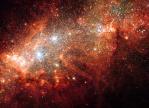End of the world was too near a couple of months ago
Scientists believe that if the blast had occurred only ten light years afar, planet Earth would have been destroyed
The day of Decmeber 27th 2004, could have become the last day in the history of all living beings on planet Earth, including humans. An unimaginably powerful blast of a neutron star rocked the Milky Way, in the area of the Constellation Sagittarius. All leading astronomic centers and satellites registered the blast. Scientists have never witnessed such a powerful explosion in space before. The blast produced the energy, the amount of which could be compared to the power that the Sun produces in 250,000 years, Itar-Tass reports. 
Astronomers were astounded with the amount of energy that was released as a result of the blast of the star on the outskirts of our galaxy 50,000 light years far away. American scientists said that the explosion occurred, when a giant black hole took up the equivalent of 300 million stars, the size of our Sun. The black hole continues emitting a vast quantity of gas, the mass of which is equal to a trillion of Suns.
The flash of radiation, which was registered on December 27th, exerted a very strong influence on the Moon and the Earth. The star, which caused the space explosion, is referred to a rare class of super-magnetic neutron stars, classified as SGR 1806-20. Scientists believe that if the blast had occurred only ten light years afar, planet Earth would have been destroyed. "We figure that it's probably the biggest explosion observed by humans within our galaxy since Johannes Kepler saw his supernova in 1604," Dr Rob Fender, of Southampton University said.
A very powerful current of gamma and X-rays appeared as a result of the star quake. Humans could feel the consequences of the neutron star explosion too: a lot of people did not feel very well that day.
Subscribe to Pravda.Ru Telegram channel, Facebook, RSS!





